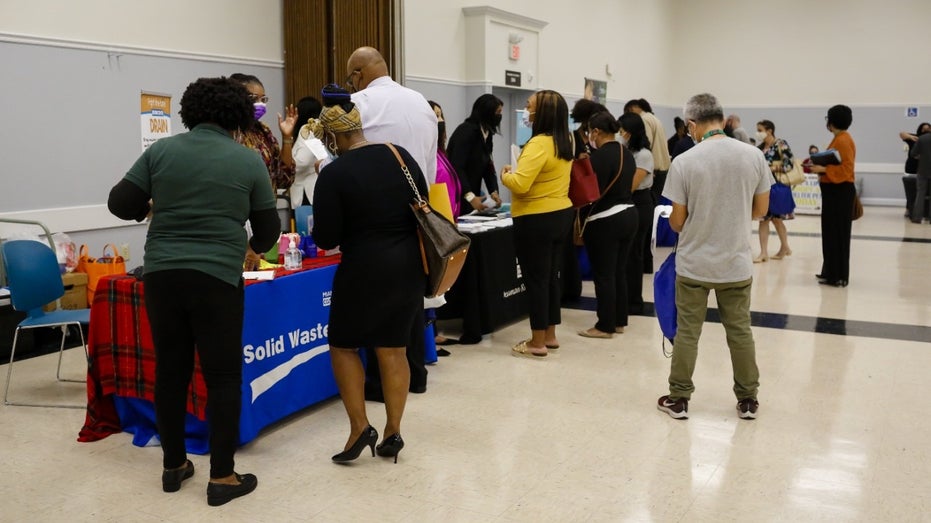Crossmark Global Investments chief market strategist Victoria Fernandez analyzes the state of the consumer ahead of the June FOMC meeting on ‘Making Money.’
Tens of millions of Americans switched jobs during the past couple of years, lured by big pay raises and abundant job opportunities – a trend that economists dubbed the “Great Resignation.”
But that may finally be coming to an end as the labor market settles into what Bank of America economists are now calling the “Great Hesitation.”
Job hoppers appear to be taking a pause, according to a new report published by the Bank of America Institute that is based on internal data. The number of workers moving from job to job is about 3% on average as of May, a notable drop from mid-2022, when it nearly hit 3.75%.
WEALTHY AMERICANS ARE ANXIOUS ABOUT MAKING ENDS MEET
An unprecedented number of workers left their jobs in 2021 and 2022 as the extremely tight labor market allowed many individuals to seek better wages, working conditions and hours.
Signage for a job fair is seen on 5th Ave. in Manhattan, New York City, on Sept. 3, 2021. (Reuters/Andrew Kelly / Reuters Photos)
Switching jobs proved to be a lucrative move for many Americans during that time period. Workers who changed jobs in July 2022 – at the height of the Great Resignation – received an 8.5% annual pay raise, which compares to the 6.7% pay raise seen by those who stayed in the same position, according to data published by the Federal Reserve Bank of Atlanta.
That rapid wage growth was a key driver of high inflation in 2022 and 2023.
However, there are signs that job switchers are receiving smaller pay bumps from their new employers than before. When the Great Resignation was in “full swing,” the median pay raise that job hoppers received was above 20%, according to Bank of America. But as of May 2024, that figure has fallen sharply to about 10%.
SMALL BUSINESSES FACE NEW THREAT: BALLOONING RENTS

Recruiters speak with job seekers during a Miami-Dade County job fair in Miami, Florida, on Dec. 16, 2021. (Eva Marie Uzcategui/Bloomberg via Getty Images / Getty Images)
“It’s notable that this figure is actually below 2019 levels,” the economists wrote. “This continued downward trend suggests the labor market is no longer as tight, and the balance of power between employer and employee has shifted back towards the hiring firm.”
The largest slowdown in job-to-job pay raises occurred for middle- and higher-income Americans. This may suggest that those individuals have less leverage and bargaining power when they are negotiating a raise for taking a job.
FED HOLDS RATES STEADY AT 23-YEAR HIGH, PROJECTS JUST 1 CUT THIS YEAR
Conversely, lower-income Americans are still seeing the strongest median pay raise from a job change.

Job seekers visit booths during the Spring Job Fair at the Las Vegas Convention Center on April 15, 2022. ((K.M. Cannon/Las Vegas Review-Journal) / Getty Images)
The labor market has remained historically tight over the past year, defying economists’ expectations for a slowdown. Economists anticipate the labor market will continue to cool in coming months as higher interest rates work their way through the economy.
GET FOX BUSINESS ON THE GO BY CLICKING HERE
The Federal Reserve raised interest rates 11 times beginning in March 2022 in an effort to rein in inflation and cool the labor market. Policymakers have suggested that fast wage growth – the product of a strong labor market – was a contributing factor to the inflation crisis that ravaged millions of Americans’ pocketbooks over the past few years.
The decline in job switchers is the latest sign that the labor market is beginning to weaken in the face of higher interest rates and stubborn inflation.
“The pay raises people are getting for job changes has slipped a little below 2019 levels, which might suggest the balance of bargaining power has shifted somewhat away from workers, particularly for middle- and higher-income job changers,” Bank of America economists wrote. “That might indicate that overall pay growth in the economy can soften, even without a particularly significant rise in the unemployment rate, which is likely good news for consumers and the Fed.”


